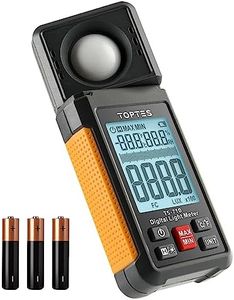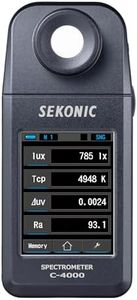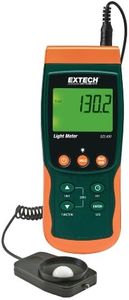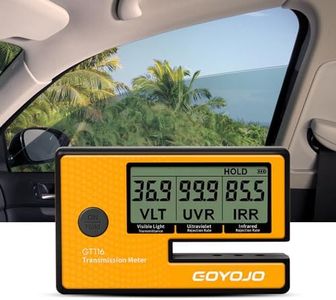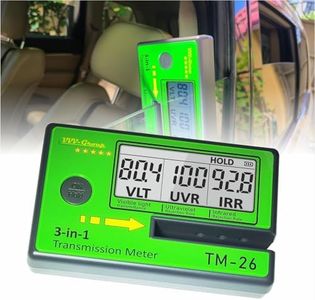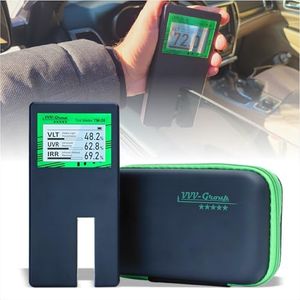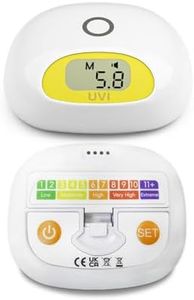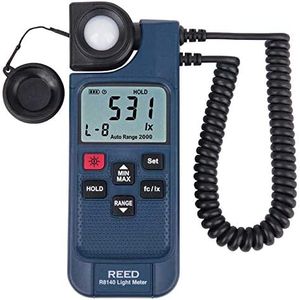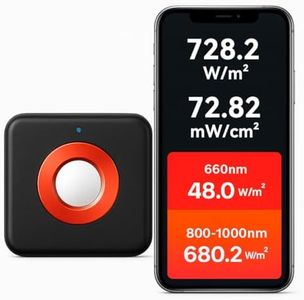10 Best Light Meters 2025 in the United States
Winner
Our technology thoroughly searches through the online shopping world, reviewing hundreds of sites. We then process and analyze this information, updating in real-time to bring you the latest top-rated products. This way, you always get the best and most current options available.

Our Top Picks
Winner
Extech LT40 LED Light Meter
Most important from
201 reviews
The Extech LT40 LED Light Meter is a well-designed tool for measuring light levels, particularly suitable for users who need accurate readings for LED lighting. One of its main strengths is its high accuracy, which is crucial for professionals in fields like photography, horticulture, and electronics where precise light measurements matter. The digital display is user-friendly, showing real-time readings along with minimum and maximum values, which helps users monitor changes effectively.
Another notable feature is the USB interface that allows for easy setup and data downloads. This can be particularly helpful for users who want to analyze data on their computers using the included analysis software, compatible with older Windows versions. The flexibility in data sampling rates—from 1 second to 24 hours—adds to its versatility, making it suitable for both quick checks and long-term monitoring.
The device’s reliance on 2 AAA batteries, while common, does mean users will need to keep replacements handy. The product's plastic construction, although lightweight and portable, may raise concerns about durability compared to more robust options made from metal or higher-grade materials. Additionally, it lacks some advanced features that other light meters might offer, such as Bluetooth connectivity for modern data transfer or extended compatibility with newer operating systems. The Extech LT40 is a solid choice for adults needing a reliable light meter, especially for LED applications. Its strength lies in its accuracy and user-friendly design, but potential buyers should consider its limitations in durability and advanced features depending on their specific needs.
Most important from
201 reviews
Amprobe LM-120 Light Meter with Silicon Photodiode and Filter
Most important from
69 reviews
The Amprobe LM-120 is a digital light meter designed for measuring visible light from various sources like fluorescent and incandescent bulbs. It offers a broad measurement range up to 200,000 lux or 20,000 footcandles, which is suitable for most industrial and scientific lighting assessments. Its dual-scale display and user-selectable auto or manual ranging make it flexible for different lighting conditions.
The device includes handy features such as data hold (which freezes the displayed reading), minimum and maximum value tracking, and zeroing for recalibrating the sensor. It also compensates for angled light, helping improve accuracy when the light isn't hitting the sensor straight on. The sensor is connected via a 1.5-meter wire, allowing easy positioning, and it comes with a protective cap to keep the sensor safe when not in use. Powered by a 9V battery, it’s relatively lightweight and portable for field use.
On the downside, the device size is somewhat bulky compared to smaller handheld meters, which might affect ease of carrying for some users. While the meter provides several useful functions, it does not include advanced features like data logging or Bluetooth connectivity that some newer models offer. This meter is well suited for users who need a reliable, versatile digital light meter with straightforward controls and solid measurement capabilities, especially in professional or industrial environments.
Most important from
69 reviews
Sekonic C-4000 Spectrometer, Professional Light Meter with Bluetooth, 1600K-40000K Range, Smartphone App Compatible, USB-C Connection
Most important from
13 reviews
The Sekonic C-4000 is a digital light meter designed for professional use, offering a good balance of precision and modern features. It covers a wide color temperature range from 1600K to 40000K, making it versatile for different lighting conditions—from warm indoor lights to daylight and beyond. Its ability to measure lux, color temperature, luminance, and color rendering index (Ra) provides comprehensive lighting data that photographers, cinematographers, and lighting professionals will find useful.
A standout feature is its Bluetooth connectivity and compatibility with a smartphone app, allowing for easier data management and remote readings, which adds convenience. The USB-C connection is also a plus for modern charging and data transfer. With a compact size and lightweight build (about 5 ounces), it’s quite portable and easy to carry on location. The clear LCD screen simplifies reading measurements, supporting ease of use.
The Sekonic C-4000 blends detailed measurement capabilities with smartphone integration, making it ideal for those who want precise, easy-to-access lighting data on the go.
Most important from
13 reviews
Buying Guide for the Best Light Meters
Choosing the right light meter can significantly enhance your photography or cinematography by ensuring accurate exposure settings. A light meter measures the amount of light in a scene, helping you to determine the optimal exposure settings for your camera. When selecting a light meter, it's important to consider various specifications to find the best fit for your needs. Here are some key specs to consider and how to navigate them.FAQ
Most Popular Categories Right Now
